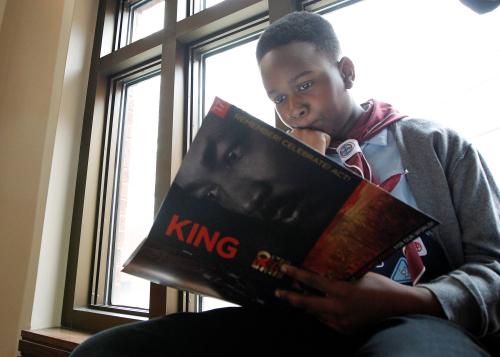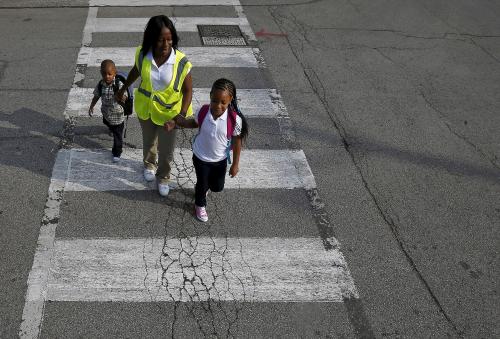“In elementary schools, Negroes lag one to three years behind whites, and their segregated schools received substantially less money per student than do the white schools.” – Dr. Martin Luther King, 1967
“[W]hite students score an average of 1.5 to 2 grade levels higher than black students in the average district.” – Reardon, et al., 2019
Dr. Martin Luther King is celebrated today as a civil rights leader and one of the great orators of the 20th century. He was also a keen commentator on social issues—one who believed in bringing scientific research to bear on such issues. King linked questions of race and class as well. In this light, I want to discuss new research about the impact of segregation on today’s education achievement gaps. Surprisingly, this evidence strongly suggests segregation’s effect on current racial gaps are largely due to segregation by poverty, rather than segregation by race. There is some complexity to this finding that requires some explanation, but first, some reminders of history.
King fought first to eliminate de jure racial school segregation, which at the time was largely a Southern phenomenon. Before and during the civil rights movement, the “equal” part of “separate but equal” was essentially a fraud. As an example, a study by the NAACP that examined Georgia school spending in the 1920s reported per pupil spending of $4.59 for Black students as compared to $36.29 for white students. In the Northern states, racial disparities in school funding were also common. In the 1960s, King wrote:
“Statistical evidence revealed in 1964 that Chicago spent an average of $366 a year per pupil in predominantly white schools and from $450 to $900 a year per pupil for suburban white neighborhoods, but the Negro neighborhoods received only $266 per year per pupil.”
Times have changed. Times have improved. De jure segregation is gone, although schools remain de facto segregated to a large extent. According to a new study by Reardon, Weathers, Fahle, Jang, and Kalogrides on segregation’s effects on racial achievement gaps, segregation reached its peak in 1968, declined through about 1980, and has remained more or less stable since then. In other words, it has been four decades since progress toward more integrated schools flat-lined. There has also been much progress toward equalized spending. This finding comes from a current study on racial spending differences: “Black … total per pupil expenditures exceed White total per pupil expenditures by $229.53.”
However, care is required in interpreting “equal spending” for two reasons. First, we mostly know about spending at the district level and not how the spending is divided up among schools within a district. Second, as Reardon, et al., write, “[H]igh-poverty schools typically have greater financial needs, given their larger shares of students identified as needing special education services and their often larger shares of English Learner students.”
So, as indicated in the opening quotes, while racial achievement gaps have been reduced since the days of King’s campaigns, the remaining gaps are still large. There are many reasons for persistence in the achievement gap, including that the legacy of separate and unequal may cause segregation in the past to have continued effects today. Looking directly at today’s situation—how important is today’s segregation per se? Black students mostly go to school with other Black students. Black students also mostly go to school with low-income students. Do either of these forms of segregation contribute to the racial achievement gap? The new work by Reardon, et al., “Is Separate Still Unequal? New Evidence on School Segregation and Racial Academic Achievement Gaps,” suggests that it is primarily poverty segregation rather than race segregation that accounts for segregation’s effect on the achievement gap.
The authors use a massive dataset that covers achievement in grades 3-8 in about half the school districts in the United States; notably, these districts include 96% of all Black public school students. The outcome variable studied is the Black/white achievement gap on test scores in math and English language achievement. (The results discussed below are for third graders.) The central question studied is the extent to which the achievement gap is explained by four differences in the average experience of Black versus white children measured by exposure to: minority schoolmates; poor schoolmates; minority neighbors; and poor neighbors.
The authors control for the usual measures that help explain the achievement gaps, and then focus on segregation per se. So the authors are telling us how much segregation matters over and above other differences that explain achievement.
The authors’ first result is that differences in exposure to minority schoolmates appears to matter a lot—if taken alone. According to my calculations using the authors’ reported outcomes, a one standard deviation increase in this measure accounts for about 9% of the total achievement gap. If exposure to minority neighbors is accounted for, the effect is even a bit larger, with the effect of schoolmates being about twice as large as the effect of neighbors. In other words, the apparent effects of racial segregation are pretty much what you’d expect.
But the authors point out that schools are also highly segregated by income level, specifically by the fraction of students living in poverty. And measures of racial segregation and “poverty segregation” are highly correlated. (Depending on the exact measures used, the reported correlation coefficients are between 0.82 and 0.93.) Is the apparent effect of race really an effect of poverty? According to the authors’ work, yes.
The authors repeat their analysis including both exposure to minority schoolmates and exposure to poor schoolmates. The effect of exposure to minority schoolmates completely disappears, while a one standard deviation increase in the Black/white gap in exposure to poor schoolmates explains about 10% of the total achievement gap. The evidence, then, is that differences in exposure to poor schoolmates rather than differences in exposure to minority schoolmates are what matters.
Finally, a horse race is run in which all four factors are included. Having minority schoolmates still doesn’t matter and having poor schoolmates still does matter. There is a small effect of exposure to minority neighbors and no effect of exposure to poor neighbors.
In summary, the authors find that the role of segregation in explaining today’s racial achievement gap comes from the fact that Black students are much more likely to go to schools with impoverished classmates, and not from the fact that they go to largely Black schools.
To be clear, this does not mean that poverty is the only thing that matters, and that race is now inconsequential. Notice that about 90% of the racial achievement gap is still unexplained in the authors’ model, meaning there’s still plenty of room for race to be impacting gaps through other policy differences both inside and outside of the classroom. Even more important, integrating by income can significantly reduce achievement gaps—and this will also mean integration by race, due to the strong relationship between the two.
If King were still alive today, would he agree that the consequences of segregation, in part, have more to do with poverty than with race per se? We can’t know, of course, where King would have come down on the question of race versus income segregation. But there is no doubt that he believed the problems were inextricably linked. (In fact, King linked solving the problems of racism to societal changes that uplifted all people.) Take this quote from a talk King gave in 1967:
“Let us turn first to the evil of racism. There can be no gainsaying of the fact that racism is still alive all over America. … The second evil that I want to deal with is the evil of poverty. Like a monstrous octopus it spreads its nagging prehensile tentacles into cities and hamlets and villages all over our nation. Some 40 million of our brothers and sisters are poverty stricken, unable to gain the basic necessities of life. And so often we allow them to become invisible because our society’s so affluent that we don’t see the poor. Some of them are Mexican Americans. Some of them are Indians. Some are Puerto Ricans. Some are Appalachian whites. The vast majority are Negroes in proportion to their size in the population.”
Note: Most quotes attributed to Dr. Martin Luther King Jr. throughout this post are from King’s book, “Where Do We Go From Here: Chaos or Community,” originally published in 1967 by Harper & Row.







Commentary
The achievement gap in education: Racial segregation versus segregation by poverty
What would Dr. King say?
January 20, 2020